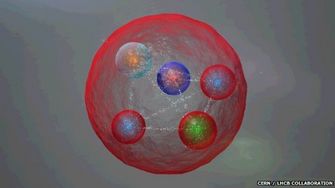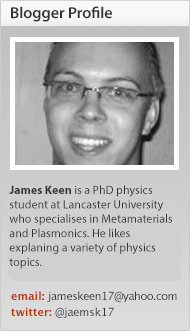« Prev Next »
Physicists at the LHC have discovered a new particle - the pentaquark.
The existence of pentaquarks was theorised half a century ago in the 1960s but so far they had been unable to be found, a story similar to that of the long-elusive Higgs boson which was finally discovered in 2012.
But what is a pentaquark? What is a quark?
Quarks are fundamental particles and an essential component of matter, combining to form composite particles called hadrons, of which there are baryons and mesons. Important baryons are protons and neutrons, which make up atomic nuclei. The quark model was proposed by both Gell-Mann and Zweig seperately in 1964 as a way of ordering hadrons, and since their discovery quarks have been key components of the Standard Model of particle physics.

Quarks are only found together within hadrons, and never on their own - a phenomenon called colour confinement. They have various basic properties including electric charge, mass, and spin. Also, they are the only fundamental particles to experience all four fundamental forces - electromagnetism, gravity, strong interaction and weak interaction. Every type of quark has a corresponding antiquark, that differ in that some properties have equal magnitiude but an opposite sign.
There a six types of quarks, called flavours - up (u) and down (d), strange (s) and charm (c), top (t) and bottom (b). Up and down quarks are the most common in the universe, whereas the other four can only be produced in high energy collisions such as cosmic rays or within a particle accelerator. Experiments at the Stanford LAC in the late 1960s provided evidence of quarks, and subsequent experiments at particle colliders have gathered evidence for all six flavours, with the top quark the last to be discovered in 1995.
Quarks are all assigned a baryon number of ⅓. Up, charm and top quarks have an electric charge of +⅔, while the down, strange, and bottom quarks have an electric charge of -⅓. Antiquarks have the opposite numbers. Baryons are made of three quarks (thus have a baryon number of 1) for example the proton (uud; charge=+1 ) and neutron (udd, charge=0), whereas mesons are made of a quark-antiquark pair (thus have a baryon number of 0).
Whilst usually thought of existing in threes and twos, the theories on quarks allowed for the existence of the pentaquark - a particle composed of five quarks, specifically made up of four quarks and an antiquark.

The pentaquark has a long history of doubtful discovery. In the past many scientists from many different research groups have all claimed to discover pentaquarks, but all were cast into doubt by subsequent alternative work. It is crucial to distinguish real signals from merely data fluctuations that can lead to erroneous conclusions of finding something.
Physicists at the LHCb studied how a subatomic particle called Lambda-b decayed into three other particles. The production of these particles sometimes involved intermediate states, referred to as Pc(4450)+ and Pc(4380)+. They conclude that this transformation can only be explained by the existence of these pentaquark states, and therefore can claim the discovery of the elusive pentaquark particle.
Adding further weight to their claim the data was able to be analysed from additional perspectives, specifically all four angles particles can move within the LHCb, allowing everything that happens in the decay process to be described. Previous experiments only measured the so-called mass distribution that can produce a statistical peak against background noise that just hints at a particle existing.
This discovery is not just important because of finding a new particle but because it confirms a entirely new way that quarks, the building blocks of matter, can exist together. Studying pentaquarks further may well enable a better understanding of how our world is made up.
Image credits:
"Standard Model of Elementary Particles" - MissMJ; licenced under CC via Wikimedia Commons
"Possible illustration of Pentaquark layout" - CERN/LHCb collaboration, image via BBC






















